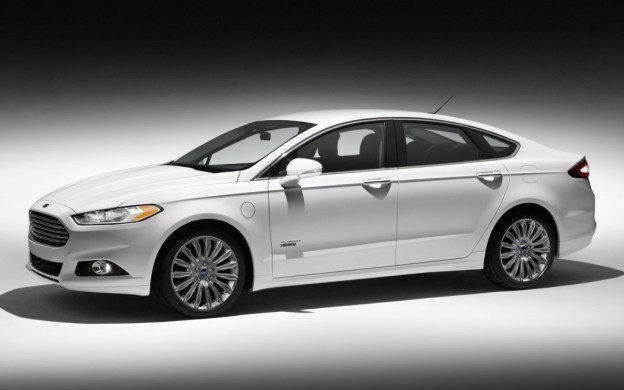 Since its unveiling, Ford has claimed that the Fusion Energi plug-in hybrid will return 100 MPGe in mixed city and highway driving. Now it’s official: the EPA has bestowed a 100 MPGe rating on the Fusion Energi
Since its unveiling, Ford has claimed that the Fusion Energi plug-in hybrid will return 100 MPGe in mixed city and highway driving. Now it’s official: the EPA has bestowed a 100 MPGe rating on the Fusion Energi
Ford is touting the Fusion as America’s “most fuel-efficient” sedan, which is true, but the Fusion is also in a class of one. The only other plug-in hybrid sedan currently available is the much dearer Fisker Karma, which is rated at 54 MPGe combined.
Since the Fusion Energi can travel up to 20 miles on electricity only, conventional hybrid sedans like the Toyota Camry Hybrid and Hyundai Sonata Hybrid can’t really compete. Look for that to change in the near future, though, with the introduction of the Honda Accord plug-in.
Relevant competition or not, the Fusion Energi’s 100 MPGe rating is still impressive. It beats the Toyota Prius plug-in (95 MPGe) and the Chevrolet Volt (98 MPGe), two hybrid mainstays.
The Fusion Energi’s fuel economy matches Ford’s other plug-in, the C-Max Energi. Both cars also use the same powertrain: a 188 horsepower, 2.0-liter four-cylinder engine, continuously variable transmission, and electric motor with lithium-ion battery pack.
With the exception of a larger battery pack, that powertrain is lifted from the regular hybrid versions of the Fusion and C-Max. Like their plug-in siblings, the Fusion Hybrid and C-Max Hybrid have identical fuel economy ratings (47 mpg in all three categories).
However, the hybrids’ EPA ratings were challenged recently by Consumer Reports, and are now under review. Ford cites the inherent variability of hybrid driving as the reason for the discrepancy.
Plug-in hybrids come with their own set of variables, so the Blue Oval crew may not be ready to celebrate until the Fusion Energi gets some real world mileage under its wheels.
The Fusion Energi goes on sale soon, with a starting price of $39,495 for a base SE model. That’s significantly more than the $27,995 Fusion Hybrid, but as with nearly everything else in the car world, you have to pay more to get more.


